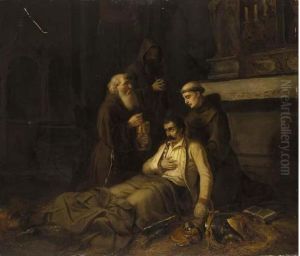Karl Joseph Litschaur Paintings
Karl Joseph Litschaur, an artist whose life spanned a significant portion of the 20th century, was born in 1908 and passed away in 1982. Despite not being a household name in the pantheon of art history, Litschaur's contributions to the art world, particularly in the realms of painting and sculpture, reflect the tumultuous and transformative periods through which he lived. His work, though not extensively documented in mainstream art historical discourse, is noted for its exploration of expressionism and modernism, movements that defined much of the artistic innovation during his lifetime.
Litschaur's early life and education were deeply influenced by the socio-political context of Europe in the early 20th century. Born on the cusp of the First World War, he grew up in an era marked by upheaval and change, which would later infiltrate his artistic themes and styles. His education likely included classical training, which was customary at the time, but as he matured, the impact of modernist movements, especially expressionism, became evident in his work. This was a time when artists across Europe were breaking away from traditional forms and techniques to explore more abstract, emotive, and sometimes disturbing themes.
Throughout his career, Litschaur navigated the challenges of being an artist in times of political and social unrest. The interwar period, followed by the Second World War and the subsequent Cold War era, presented significant obstacles, including material shortages, censorship, and the potential for artistic persecution. Despite these challenges, Litschaur remained committed to his art, developing a style that was both personal and reflective of the broader existential queries that pervaded European art.
His body of work, though not as widely recognized as that of his contemporaries, encompasses a range of mediums, including oil paintings, watercolors, and sculptures. Litschaur's themes often grappled with the human condition, exploring the complexity of emotion and the struggle of existence in a rapidly changing world. His approach to form and color, while rooted in the traditions of expressionism, also hinted at the emerging abstract expressions that would dominate the post-war art scene.
Karl Joseph Litschaur's death in 1982 marked the end of a career that, though not extensively documented, contributed to the rich tapestry of 20th-century art. His works, preserved in private collections and occasionally featured in retrospective exhibitions, offer a glimpse into the life of an artist who navigated the complexities of his time with resilience and creativity. Litschaur's legacy, while subtle, is a testament to the enduring power of artistic expression amidst the ever-changing landscape of history.

